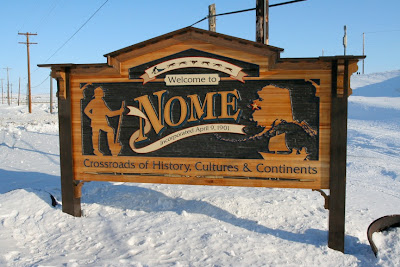In the middle of March we went to Nome for a couple of days to see the first Iditarod dog teams come in. Nome, in western Alaska, is the finish for the 1049 mile (ca 1700 km) Iditarod dogsled race from Anchorage; it is also the commercial centre for northwest Alaska. Nome started as a gold mining town, it became famous in 1899 when gold was found on the beach and in 1900 it was the largest city in Alaska with about 20000 inhabitants. This number has now dropped to about 2000 inhabitants, but there is still gold mining in the area and it is still possible to pan for gold on the beach. Nome is on the coast and therefore windier than Fairbanks, so it felt a lot colder. The first 1.5 days, waiting for the Iditarod winner to arrive, we explored Nome, visited the museum, went to a performance of the local King Island dancers, walked on the sea ice and 'explored' the Nome 'national forest' (they plant old Christmas trees and large animal statues on the sea ice). And, of course, we kept checking the status of the Iditarod teams, many of which had decided to shelter from the major storm battering the coast and the Yukon river in these days. Wednesday morning, however, the town's firealarm went off, indicating a dog team approaching Nome, and we raced down to the finish chute to see Lance Mackey arriving with 15 dogs to become the Iditarod winner for the third year in a row. From now on, every time a new dog team approached Nome, the firealarm would go off and tourists and locals would come out of the hotels, pubs and workplaces to cheer the incoming team to the finish. A great atmosphere, although the TV teams and reporters were a nuisance, crowding around the dogs and sled blocking the view for others. On Thursday morning we volunteered to work the early morning shift in the dog lot, taking care of dropped dogs and helping the vets to check the incoming dog teams. A great trip!
Welcome to Nome

A familiar face: Roald Amundsen. He landed near Nome with his airship Norge after the first transpolar flight in 1926.
Een bekend gezicht: Roald Amundsen, de beroemde Noorse poolreiziger landde in 1926 in de buurt van Nome met de zeppelin Norge na de eerste succesvolle vlucht over de noordpool.

A performance by the Kong Island dancers and musicians.
Een voorstelling van de King Island dansers en muzikanten.

The Nome 'national forest'
Het 'nationale bos' van Nome

Iditarod 2009 winner Lance Mackey arriving at the finish
Aankomst van Iditarod 2009 winnaar Lance Mackey

Lance Mackey's two leaddogs get some well deserved attention
Lance Mackey's twee leiders krijgen wel verdiende aandacht

Different means of transport for different seasons
Transport type hangt af van het seizoen

Sebastian Schnuelle, with his father, on their way to park his dog team after finishing number 2
Sebastian Schnuelle, en zijn vader, op weg naar de hondenrustplaats nadat hij als tweede is binnengekomen

Gold dredge
Goudbaggermachine

Running up the bank from the sea ice...
Vanaf het zeeijs omhoog rennen...

... onto the main street in Nome to the finish line
...naar de hoofdstraat van Nome op weg naar de finish

View of the hills in western Alaska from the plane
Uitzicht over de heuvels in west Alaska vanuit het vliegtuig

View of the mighty Yukon river
Uitzicht over de Yukon rivier

View of Denali
Uitzicht naar Denali




























































